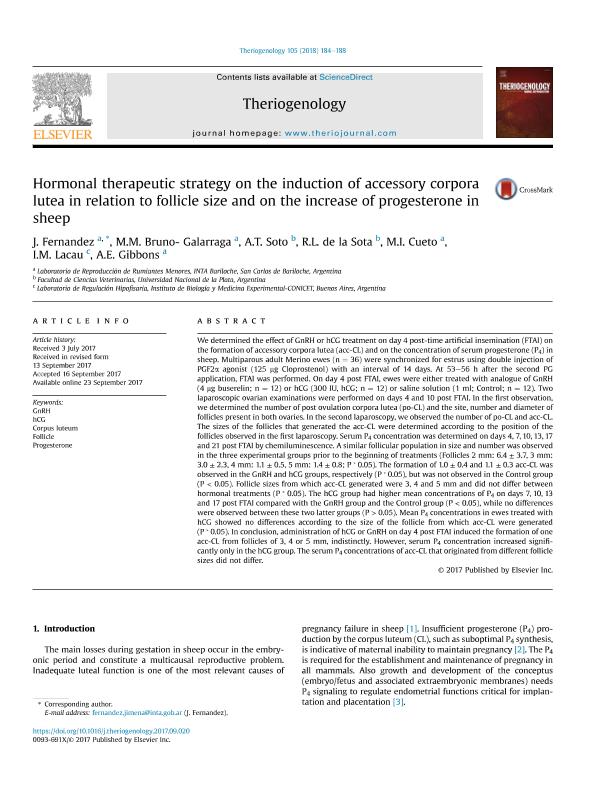Mostrar el registro sencillo del ítem
dc.contributor.author
Fernandez, Jimena Beatriz

dc.contributor.author
Bruno Galarraga, María Macarena

dc.contributor.author
Soto, A. T.
dc.contributor.author
de la Sota, Rodolfo Luzbel

dc.contributor.author
Cueto, M. I.
dc.contributor.author
Lacau, Isabel María

dc.contributor.author
Gibbons, A. E.
dc.date.available
2018-01-10T17:59:49Z
dc.date.issued
2017-09
dc.identifier.citation
de la Sota, Rodolfo Luzbel; Lacau, Isabel María; Gibbons, A. E.; Cueto, M. I.; Soto, A. T.; Fernandez, Jimena Beatriz; et al.; Hormonal therapeutic strategy on the induction of accessory corpora lutea in relation to follicle size and on the increase of progesterone in sheep; Elsevier Inc; Theriogenology; 105; 9-2017; 184-188
dc.identifier.issn
0093-691X
dc.identifier.uri
http://hdl.handle.net/11336/32839
dc.description.abstract
We determined the effect of GnRH or hCG treatment on day 4 post-time artificial insemination (FTAI) on the formation of accessory corpora lutea (acc-CL) and on the concentration of serum progesterone (P4) in sheep. Multiparous adult Merino ewes (n = 36) were synchronized for estrus using double injection of PGF2α agonist (125 μg Cloprostenol) with an interval of 14 days. At 53–56 h after the second PG application, FTAI was performed. On day 4 post FTAI, ewes were either treated with analogue of GnRH (4 μg buserelin; n = 12) or hCG (300 IU, hCG; n = 12) or saline solution (1 ml; Control; n = 12). Two laparoscopic ovarian examinations were performed on days 4 and 10 post FTAI. In the first observation, we determined the number of post ovulation corpora lutea (po-CL) and the site, number and diameter of follicles present in both ovaries. In the second laparoscopy, we observed the number of po-CL and acc-CL. The sizes of the follicles that generated the acc-CL were determined according to the position of the follicles observed in the first laparoscopy. Serum P4 concentration was determined on days 4, 7, 10, 13, 17 and 21 post FTAI by chemiluminescence. A similar follicular population in size and number was observed in the three experimental groups prior to the beginning of treatments (Follicles 2 mm: 6.4 ± 3.7, 3 mm: 3.0 ± 2.3, 4 mm: 1.1 ± 0.5, 5 mm: 1.4 ± 0.8; P ˃ 0.05). The formation of 1.0 ± 0.4 and 1.1 ± 0.3 acc-CL was observed in the GnRH and hCG groups, respectively (P ˃ 0.05), but was not observed in the Control group (P < 0.05). Follicle sizes from which acc-CL generated were 3, 4 and 5 mm and did not differ between hormonal treatments (P ˃ 0.05). The hCG group had higher mean concentrations of P4 on days 7, 10, 13 and 17 post FTAI compared with the GnRH group and the Control group (P < 0.05), while no differences were observed between these two latter groups (P > 0.05). Mean P4 concentrations in ewes treated with hCG showed no differences according to the size of the follicle from which acc-CL were generated (P ˃ 0.05). In conclusion, administration of hCG or GnRH on day 4 post FTAI induced the formation of one acc-CL from follicles of 3, 4 or 5 mm, indistinctly. However, serum P4 concentration increased significantly only in the hCG group. The serum P4 concentrations of acc-CL that originated from different follicle sizes did not differ.
dc.format
application/pdf
dc.language.iso
eng
dc.publisher
Elsevier Inc

dc.rights
info:eu-repo/semantics/openAccess
dc.rights.uri
https://creativecommons.org/licenses/by-nc-nd/2.5/ar/
dc.subject
Corpus Luteum
dc.subject
Follicle
dc.subject
Gnrh & Hcg
dc.subject
Progesterone
dc.subject.classification
Otras Ciencias Veterinarias

dc.subject.classification
Ciencias Veterinarias

dc.subject.classification
CIENCIAS AGRÍCOLAS

dc.title
Hormonal therapeutic strategy on the induction of accessory corpora lutea in relation to follicle size and on the increase of progesterone in sheep
dc.type
info:eu-repo/semantics/article
dc.type
info:ar-repo/semantics/artículo
dc.type
info:eu-repo/semantics/publishedVersion
dc.date.updated
2017-12-15T14:32:43Z
dc.journal.volume
105
dc.journal.pagination
184-188
dc.journal.pais
Estados Unidos

dc.description.fil
Fil: Fernandez, Jimena Beatriz. Instituto Nacional de Tecnología Agropecuaria. Centro Regional Patagonia Norte. Estación Experimental Agropecuaria San Carlos de Bariloche; Argentina. Consejo Nacional de Investigaciones Científicas y Técnicas; Argentina
dc.description.fil
Fil: Bruno Galarraga, María Macarena. Instituto Nacional de Tecnología Agropecuaria. Centro Regional Patagonia Norte. Estación Experimental Agropecuaria San Carlos de Bariloche; Argentina. Consejo Nacional de Investigaciones Científicas y Técnicas; Argentina
dc.description.fil
Fil: Soto, A. T.. Universidad Nacional de La Plata. Facultad de Ciencias Veterinarias; Argentina
dc.description.fil
Fil: de la Sota, Rodolfo Luzbel. Universidad Nacional de La Plata. Facultad de Ciencias Veterinarias; Argentina. Consejo Nacional de Investigaciones Científicas y Técnicas; Argentina
dc.description.fil
Fil: Cueto, M. I.. Instituto Nacional de Tecnología Agropecuaria. Centro Regional Patagonia Norte. Estación Experimental Agropecuaria San Carlos de Bariloche; Argentina
dc.description.fil
Fil: Lacau, Isabel María. Consejo Nacional de Investigaciones Científicas y Técnicas. Instituto de Biología y Medicina Experimental. Fundación de Instituto de Biología y Medicina Experimental. Instituto de Biología y Medicina Experimental; Argentina
dc.description.fil
Fil: Gibbons, A. E.. Instituto Nacional de Tecnología Agropecuaria. Centro Regional Patagonia Norte. Estación Experimental Agropecuaria San Carlos de Bariloche; Argentina
dc.journal.title
Theriogenology

dc.relation.alternativeid
info:eu-repo/semantics/altIdentifier/doi/http://dx.doi.org/10.1016/j.theriogenology.2017.09.020
dc.relation.alternativeid
info:eu-repo/semantics/altIdentifier/url/http://www.sciencedirect.com/science/article/pii/S0093691X1730451X
Archivos asociados
